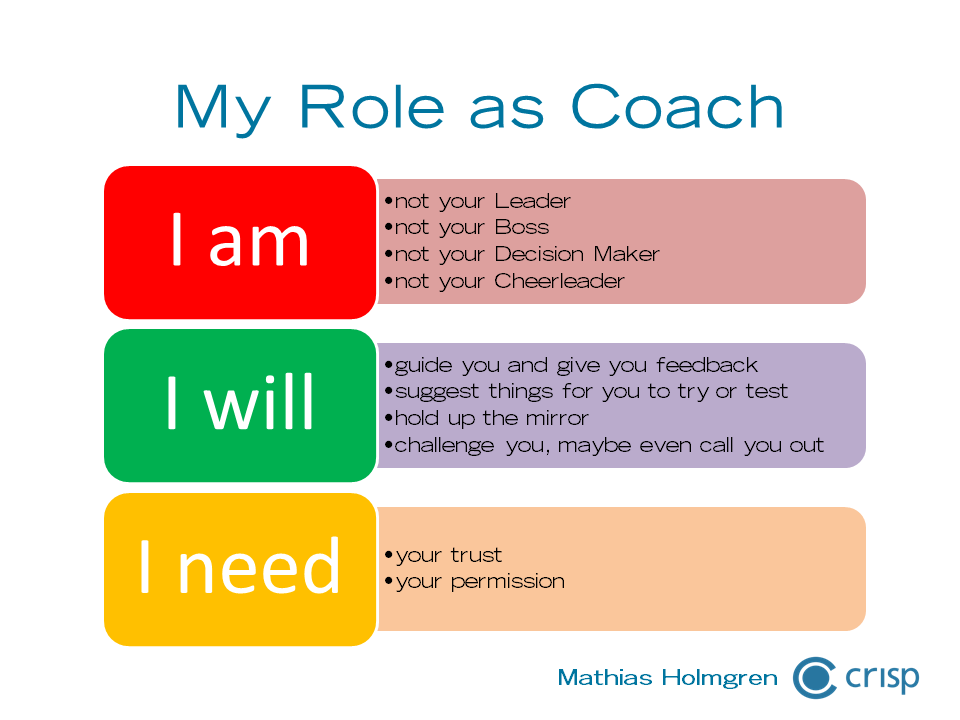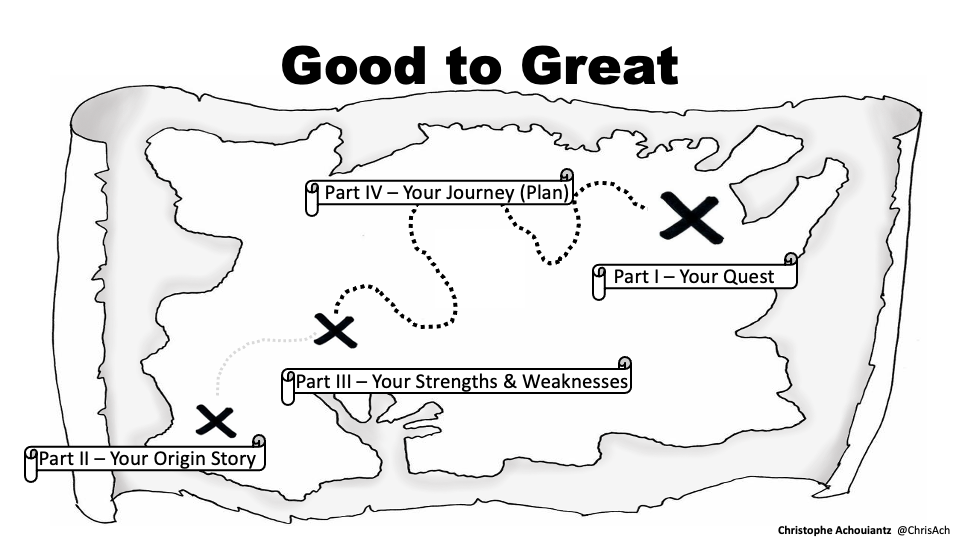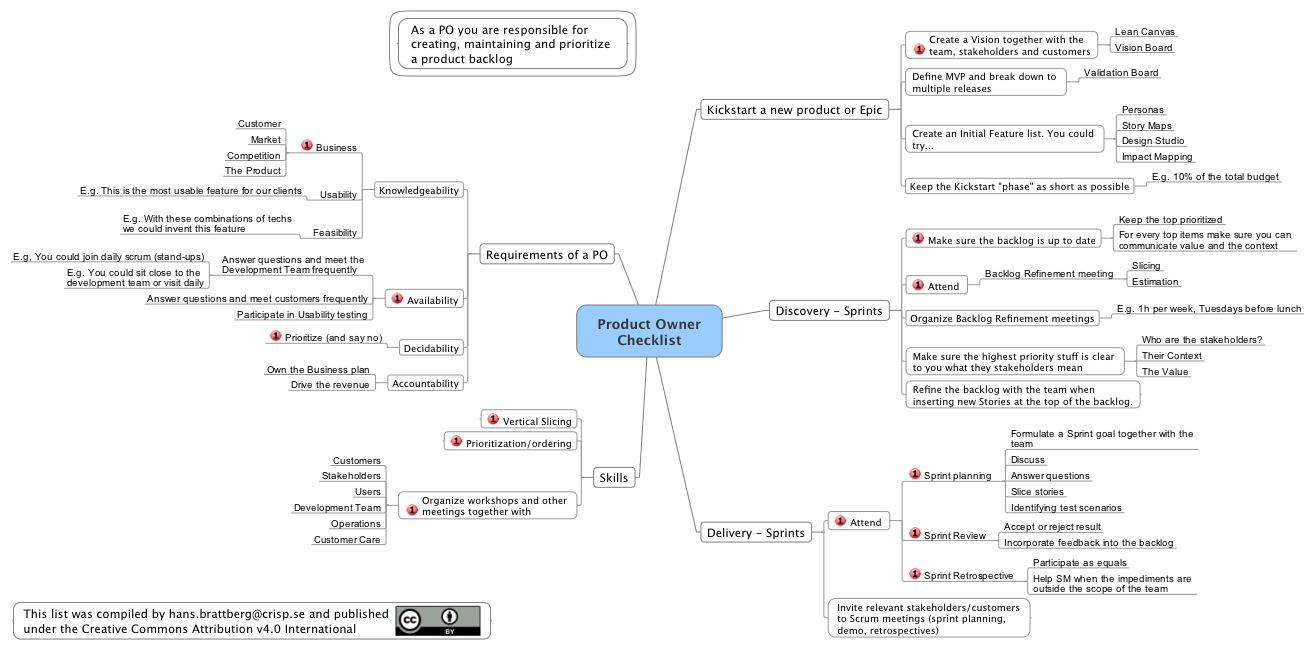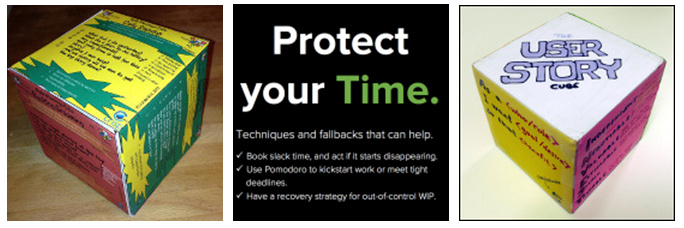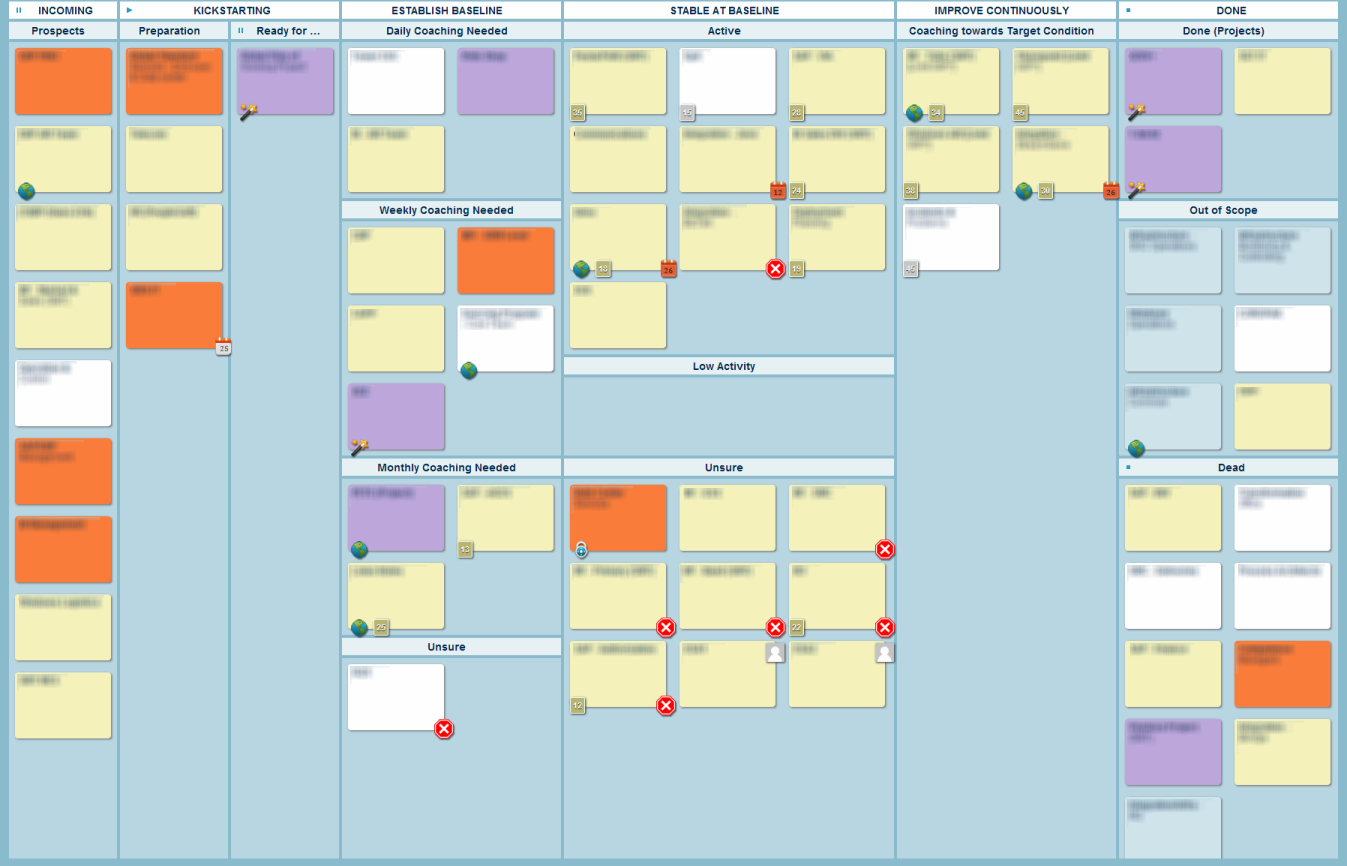A few days ago I was asked an interesting question by a product team coach at a new client that I want to share with you. Q: – What can I do to help my team practice discovery? I understand it for customer experience facing teams, but my team is an enabling platform team. What
Continue readingWhy Professional Coaching matters to an Agile Coach
Professional coaching is one of the four stances of an Agile Coach, and the reason for the word “Coach” in Agile Coach. But yet we see so many misconceptions of what professional coaching is and when to use it. I was recently involved in a couple of discussions about this on LinkedIn, and was surprised that apparently many Agile Coaches still don’t really know what professional coaching is. Here’s why it matters to an Agile Coach.
Continue readingÖvning kring grupputveckling
Mia Pilebro, agil coach på Arbetsförmedlingen, och jag, genomför ett Scrum Master program med deltagare från två av enheterna på arbetsförmedlingens IT-avdelning. Programmet innehåller sex träffar med en tvådagars workshop som inledning, fyra träffar, så kallade Learning Labs, varannan vecka, och till sist en avslutande heldag för gemensam reflektion och sammanfattning av programmet. Under den andra Learning Lab-träffen som vi hade för några veckor sedan jobbade vi kring grupputveckling; hur utvecklas en grupp från det att den bildas initialt tills det att den möjligtvis blivit en högpresterande enhet? Vad är det för mönster som visas i olika faser av gruppens utveckling, dvs vad är det för beteenden vi generellt kan uppmärksamma och hur kan man beskriva vad som tar gruppens fokus och energi? Dessutom tittade vi på hur ledarens agerande behöver förändras utifrån där gruppen befinner sig i sin utvecklingsresa.
Mia och jag organiserar träffarna med korta teorigenomgångar blandat med gruppövningar för att skapa en bra miljö för lärande och utveckling. Vid detta tillfälle skapade vi en kortlek och spelplan utifrån Susan Wheelans forskning kring grupputveckling, hennes modell ”Integration Model of Group Development” (IMGD), som beskriver fem faser en grupp kan utvecklas genom:
- Tillhörighet och trygghet
- Opposition och konflikt
- Tillit och Struktur
- Arbete och produktivitet
- Avslut
Då vi endast fokuserade på de fyra första faserna under vår träff innehåller spelplanen inte den sista avslutande fasen.
Workshopen blev väldigt lyckad med både hög energinivå och ett bra lärande kring ämnet. Jag vill därför beskriva hur vi organiserade delen där gruppen fick arbeta kring grupputveckling med hjälp av kortleken vi skapade, och också dela materialet att använda hos era arbetsplatser. Länk till spelkort och spelplan finns längre ner i denna artikel.
Förutsättningar för en positiv grupputveckling
Jag utbildade mig nyligen till handledare för försvarshögskolans koncept Utvecklande Ledarskap (UL); fem mycket inspirerande och lärorika dagar. Förutom ny kunskap har jag dock också med mig upplevelsen kring kraften i grupputveckling när den blir som bäst. Under kursen satt och jobbade vi i kvarteret där vi både hjälpte varandra förstå kursinnehållet men också förberedde och genomförde en del av den normala UL-kursen inför övriga kursdeltagare. Det är fascinerande hur starkt relationerna inom en grupp kan utvecklas, och från det att en tydlig teameffekt kan växa fram, efter så kort tid som några få dagar.
Det fick mig att fundera på vad det var som hände under kursen som gjorde detta möjligt. Vid reflektionen kring hur utbildningen var strukturerad, den miljö vi befann oss i, handledarnas agerande och vad vi gjorde i kvartetterna, landade jag i att nedanstående fyra aspekter hjälpte oss till att formeras till kraftfullt team under veckan som gick:
- fokus på att bygga en trygg miljö,
- Vi hade väldigt tajta målsättningar att arbeta mot
- Det fanns möjligheten till frekvent feedback på de resultat vi skapade, samt vi gav varandra löpande feedback på varandras prestationer
- och vi var en liten och komplett gruppering som skulle lösa uppdraget tillsammans självständigt.
Anti-Agile – skapa insikter kring förändringsbehov
Anti-Agile är en av mina favoritövningar att facilitera vid uppdrag hos kund. Använder man denna övningen internt inom en organisation så synliggör man ofta många dysfunktioner som finns inom organisationen; kulturellt, strukturellt och hur man arbetar. Övningen fungerar också väldigt bra som en murbräcka i att bryta tron att allt fungerar så bra som det är, och föreställningen att vi är så agila som vi möjligen kan bli. Det senare är många gånger en utmaning då en stark föreställning om sin egna förträfflighet är ett stort hinder att ta sig över som coach för att få kunder att öppna upp sig för coaching och vägledning i sin arbetssituation.
Pair Coaching
Just like pair programming, there are a lot of benefits to pair coaching. In fact, the positives – two pairs of eyes, direct feedback, observation from two different perspectives – are even stronger motivators for pairing up when coaching! We see a lot of pairing when it comes to teaching classes, and larger facilitations, why not apply the same benefits to coaching as well!
The coaching context
In an individual coaching session, there are a lot of things going on. First, there is the content of the conversation. Then there are the thought processes and emotions within both the coach and the person being coached. As well as the communication and dynamics of the relationship between them. This is already a complex situation that can benefit from an added perspective. Imagine the complexity when we start talking about team or group coaching.
Evolutionär förändring
Inledning
Ser jag tillbaka på mina år som konsult och coach på Crisp har det skett en rätt stor förändring i vilka typer av uppdrag vi får. Många organisationer möter en allt mer föränderlig omvärld med snabbfotade kunder; är de inte nöjda med det utbud som organisationen levererar går det till en konkurrent i stället. Det räcker inte längre med att enskilda team fungerar bättre; hela organisationer behöver förbättras för att nödvändiga effekter skall skapas.
För att lyckas med förändringsarbetet behöver vi:
- Utgå från att organisationer är komplexa system vilket kräver en organisk förändring snarare än ett plandrivet och mekaniskt sådan.
- Genomför förändringen evolutionärt drivet genom de hinder som teamen upplever,
- Successivt forma den struktur och arbetssätt som just den specifika organisationen bäst behöver för att leverera värde.
Bootstrapping a Working Agreement for the Agile Team
I suspect that running a session with a team to help them bootstrap a Working Agreement, is the single most common workshop I’ve been facilitating the last couple of years. And I’ve learned a lot of what works for me (and what doesn’t work). In my experience, this approach works equally well for the agile team, the department management group and the steering board team. This blog is me documenting how I ended up facilitating these sessions.

For me, a Working Agreement captures the expectations we have on each other within the team when we collaborate and communicate. I’ve seen teams call it “Code of Conduct” or “Ways of Working”. I call it Working Agreement. You call it whatever makes sense for you.
Running a Working Agreement workshop as early as possible is crucial for setting the team up for success. Preferably it’s done during the team’s two-day kick-off offsite, or at least within the first few weeks as a planned structured workshop.
Bucket Estimation – How to estimate a really large backlog
So you have a LARGE backlog and you have decided that you need to estimate it.
Not on board? Still undecided? Go read my previous post on the tradeoffs between estimating and not estimating large backlogs.
Still reading? Ok, let’s get to it!
You can do larger scale estimation in MANY ways. What I will share with you here is just one way I have found to do it effectively, with enough accuracy at a reasonable cost. It requires some pre-conditions, such as having a team with an established way of working and some way of estimating on the team level, so it may not fit your situation. But if it does it is probably worth your time to check out.
Large Backlog – To estimate or not, that is the question!
Estimation seems to have gotten a bit of a bad reputation lately.
One misconception I sometimes see is that estimation beyond just a few weeks is “not agile”. Another trend is that some people advocate against doing estimation at all mostly because they view it as a beginner tool, so by not estimating we are no longer beginners.
To me doing estimation or not does not really say much about “how agile you are”. The way I look at it is that we should estimate when the reasons to do so outweigh the reasons not to do so. That simple.
In some scenarios this also includes doing estimation of large backlogs.
So in this article I want to share what I see as some of the reasons FOR and AGAINST doing estimation of a larger backlog. You can then decide for yourself if your situation justifies doing it or not.
Agile Coach to Team Relationship
The role or function of an agile coach can be be a bit of a challenge to wrap your head around if it is new to you. Depending on your situation and on agreements with people in your organization, an agile coach could work with a wide range of responsibilities. It could be working closely
Continue readingCore Protocols – effective communication
– Having rules for communication is stupid!
– What was your intention with calling the rules stupid?
– Well, I’m sorry, I didn’t mean anything negative towards you, of course. I just don’t find such rules necessary at all. We have been communicating with each other since we were small.
– Okay, I understand what you are saying. But, hear me out…
Using the 7 deadly sins to motivate your workforce
So your organisation is going ”agile” and talking about ”collaborations” between teams? You, as the big boss, are starting to feel powerless and not in control of the efficiency of YOUR teams? Let me give some tips on how to turn that around so all progress can be traced back to you. I mean, as their mighty leader, you do deserve all the credit for their work.
Trading control for great products – the Telia TV team example
Adapting to accelerating change
In a world where the speed of change seems to accelerate almost exponentially, it is only natural that an organization’s way of working must be constantly challenged and improved – especially in the highly competitive media business.
This text, which was inspired by winning an award (we will return to that), is the outcome of a joint effort between Michael Göthe, Agile Coach at Crisp, and Jens Abrahamsson, Agile Coach at Telia Company’s TV & Media Backend department. In it, we describe parts of the always-ongoing journey towards a more lean and agile way of working at the Telia TV team.
As always when looking back at a complex change process it is not possible to copy what we did but our intention is to share useful learnings, practices, and tools that can inspire you on your change journey, in your context.
The iZettle Example: Decentralized Tech Development In Practice (Case Study)
Don’t stand in the way of great employees.
That’s one of the operational mantras that guide the finance technology company iZettle.
Two others are “Keep the startup spirit strong” and “Stay adaptable to changing market needs.”
In this blog post, we share some of the things we are implementing and tweaking at iZettle to keep producing great results and attracting in-demand, talented developers. My role has been to assist the tech development organization in making this work.
(Another blog post coming soon will cover the transformation of making the whole company agile, while this post focus on the practices that are put in place to keep a high performing, decentralized tech development organization at iZettle.)
Let’s begin by facing the reality of fast-growing startups.
The organizational challenges for most fast-growing startups
Most startups want a flat organization to keep their entrepreneurial juices flowing, but when new employees join in a steady stream there eventually comes the point where the founders or upper management feel overwhelmed by chaos.
Things get confusing.
Employees aren’t seen.
No one seems to know what’s going on.
What usually happens for most start-ups at this point is that bureaucracy processes start piling up. Layers of management are added, and project managers are introduced to coordinate the chaotic environment. And so are written reports for managers to send to upper management, and silos are building up between different departments. And decisions are taken somewhere else.
And then what happens?
Usually, entrepreneurial enthusiasm suffers and so does talent motivation and speed of innovation.
And that is exactly what iZettle wants to prevent.
But that is easier said than done when a company grows like a wildfire.
Team Shapes – Simulating the challenges with component teams
A common pitfall for large and medium size organizations who are adopting Agile is to organize teams based on software component boundaries instead of feature teams. Some of the aspects of long term code ownership are more straightforward this way, but the negative consequences in terms of business agility and costs of coordination are huge. A few years back I designed a simulation exercise that I call Team Shapes which illustrates some of the issues and now I would like to share this simulation with the community.Continue reading
4+3+2+1 Team Success Factors
I’ve now published a new YouTube video where I present 4+3+2+1 Team Success Factors, a model that captures and describes what you can do to help make your team become strong and successful. These 10 factors are split into four groups. * The first group describes four dialogs we need to have as a team. * Next
Continue readingX-team Silos Game – getting in T-shape
Cross functional teams are complete in expertise but not necessarily collaborative. Sometimes team members hold on to their expertise too much and the team does not perform to its potential. This Lego game illuminates the difference when members allow themselves to take on tasks outside their expertise, being so called T-shaped. Play the game to kick-start your change and create collaboration.
From Good-Enough to Great: the Workshop
Here comes the slides from the Workshop I’ve held at the Lean Kanban North America 2016 conference in San Diego: From Good-Enough to Great from Christophe Achouiantz What the Workshop is about From good-enough to greatYou’ve had some success with you Kanban System: you’ve managed flow and quickly increased your capability. But now the energy
Continue readingBetter meetings with the Core Protocols

Good meetings is very much about achieving deep collaboration. But collaboration is often hard. We go into meetings with different modes, intentions, and expectations. How can we make meetings both more fun and energetic? Surprisingly enough: maybe by being more formalized.
Continue reading
The importance of size and proximity
We have translated our blog on team size and proximity to english. If you prefer to read it in Swedish it’s called Storlek och närhet har betydelse. The english version you’ll find at Nomad8 site, because Jimmy Janlén is currently in New Zealand. 🙂
Continue readingAgile Topics card deck
The other week I got the idea to create simple conversation cards. Each card represents an agile practice, a conversation topic or an abstract theory. Now I’ve drawn 96 cards. I simply couldn’t stop 🙂
A Scrum Product Owner Checklist as a mind map
If you wonder what a Scrum Product Owner need to do, here’s the checklist (in form of a mind map) for you!
Kickstart workshops with energizing exercises
Do participants fade away in a long “zzz..” or the perfect time to update yourself on what your friends are doing on FB? No more! Check out the Energizer bible for nifty tricks for keeping up the energy level during workshops and trainings.
Continue readingThe House of Agile – A visualisation of the core of Agile
What is Agile, actually?
Have you ever asked yourself the question, ”what is Agile”? Ever been asked the question and found yourself looking for the easy answer? The true answer is of course that Agile is the Agile manifesto but do you know anybody who can recite the manifesto just out of his or her head? When asking what is Agle, it’s more likely you will get the answer that Agile is about being flexible or about high efficiency. Some will say Agile is about having a Scrum Master, daily stand-up meetings and notes on a white board. I think Agile is much more than that and in this post I will tell you the answer, the short answer, I have found after many years looking.
Is it important to know what Agile actually is? Yes, of course. If you don’t know, how can you know in which direction to change your way of working when you decide to go Agile. By the way, Agile is a direction how to improve your way of working, not a place or a fixed description of how to work.
To make Agile easy to understand I will borrow a symbol from Lean, the house
Concept Cubes
A while ago I was asked to help out create a checklist for a team, a checklist that could tell something about whether or not a user story was “good enough”. I opened PowerPoint and starting to ponder over how I could help. I immediately realized that a presentation would be boring, shown once and then forgotten, and not invite to curiosity. I put my laptop away and created a cube instead.
A couple of days later I showed it to a friend and colleague (Viktor Sessan, Agile Coach at Spotify), who were also very intrigued by the concept, and we started to talk about how to take this further.
This is the result 🙂 We believe that if you let an idea loose, and it is a good idea, great things will happen.
Delagardrivet och upplevelsebaserat lärande
I juni kommer min kollega Jimmy Janlén och jag hålla kurs i deltagardrivet och upplevelsebaserat lärande. Vill vi hjälpa andra att upptäcka och praktisera sätt att skapa sant engagerande och lärande undervisning, presentationer och workshops. Kanske slipper ni då mina egen långa resa bort från katedern.

Så vitt jag minns det var jag 24, kanske 25 år. Jag och min vän Göran hade blivit inbjudna att hålla föredrag inför en större samling människor. Det hade jag aldrig gjort förut. Visst var jag van att prata inför andra människor, från seminarierna på universitetet till redaktionsmötena på vår lilla tidsskrift, men inte att hålla tal. Jag gjorde det som kändes säkrast. Jag skrev ett tal och läste sedan upp det.
Förutom att det tog jättelång tid att skriva talet, så kändes det inte bra att stå där och läsa rakt upp och ner. Visst försökte jag läsa med inlevelse och dramatik, ungefär som när man läser högt för barnen, men det kändes ändå inte bra. Höll inte åhörarna på att somna? Lärde de sig alls något? Det går att trollbinda en publik med högläsning, om man berättar en riktigt bra historia. Göran var bra på det, men inte jag. Något behövde jag göra annorlunda.
NEINification – training your organization to achieve nothing
Reign by terror has been long known. But dictators are too short lived I’m afraid. What a true master knows, is how to tame an organization so bad it fails to achieve.. anything, without officially saying no. Look at Berlusconi – a master in action!
Here’s the Evil Coach top ten of how to make sure every initiative fail – without ever having to say no!
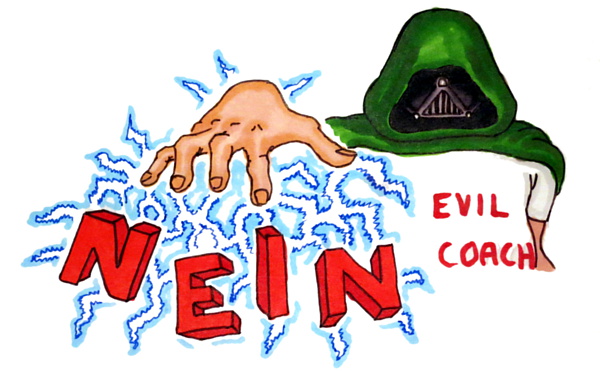
How to Keep Track of 50+ Teams
Few coaches and many teams. How does that work? In the Kanban Kick-start Field Guide you mention that you have kick-started more than 50 teams. How do you keep track of the teams and their status? For our Kanban-coach team, each team really is a work item and, unsurprisingly, we try to see and understand
Continue readingDepth of Kanban – A Good Coaching Tool
I really got inspired reading Håkan Fors’ article on “Are the Kanban practices in the right order”. Not only did he linked to a presentation Johan Nordin and I did at Lean Kanban Central Europe 2011 (which is always good), he also presented a way to visualize the maturity – or depth – of a
Continue reading



